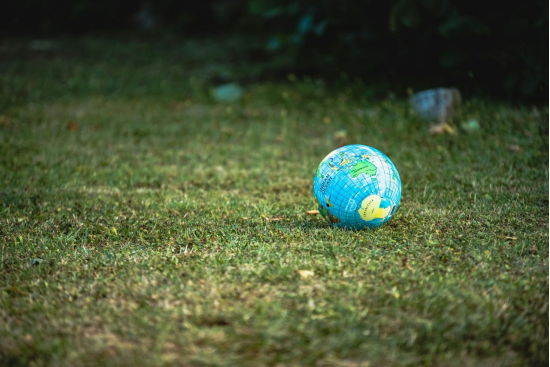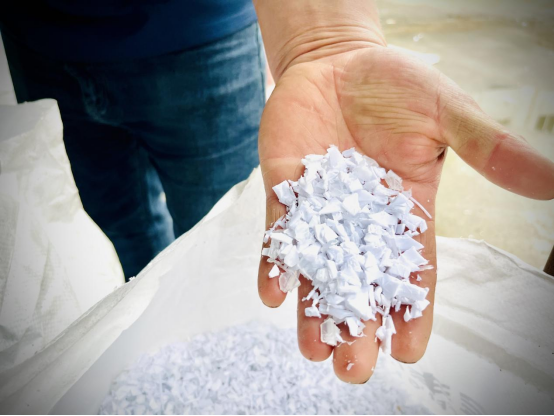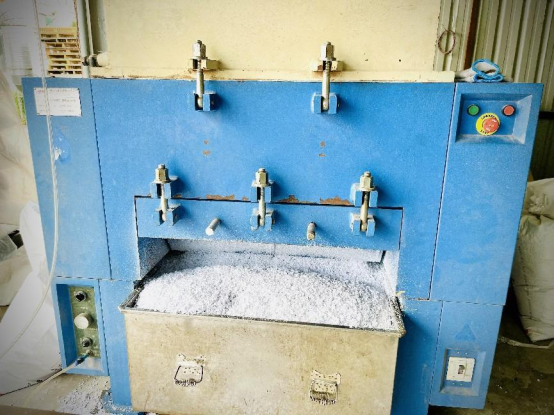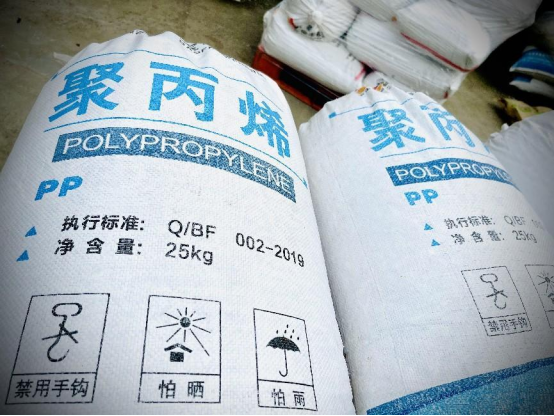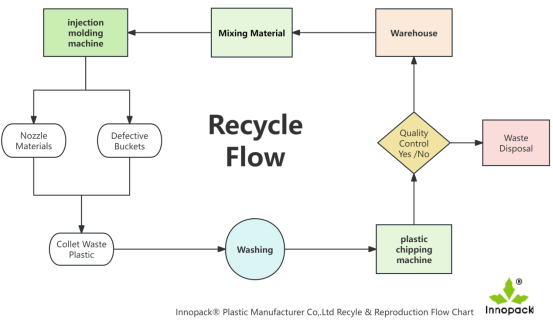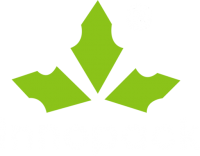Reducing greenhouse gas emissions is a critical effort in Innopack® sustainable development. As a professional plastic industrial manufacturer, our FBA standardized, food-grade, long-lasting, and recyclable plastic buckets are less energy-intensive production, and their lightweight nature makes them an excellent tool for curbing emissions.
This article standardizes the management of sustainable recycled plastic production and utilization to ensure orderly and systematic control, aiming to minimize raw material consumption and regulate the proper and rational use of nozzle materials in injection molding machine production processes.
Application:
Pro rata feed and chargerecycle HDPE/PP plastic flanks into the hopper and re-produce new buckets according to the volume of mixing percentage with pure virgin resins.
Produce 100% recyclable buckets by using recycled plastic flanks(HDPE/PP).
Our Duty:
- Manufacturing Department:responsible for identifying and classifying produced water outlets.
Responsible for the classification, identification, storage, and storage of the nozzle and crushed nozzle materials.
Responsible for the proportion of raw materials and water materials added, mixing and marking, and classification of mixed materials.
- Warehouse of Administration Department:be responsible for the clear identification, storage, protection, distribution, and ledger establishment of the inlet materials.
Responsible for issuing the ratio requirements of raw materials and water inlet materials according to regulations.
- Quality Department:responsible for random checks and confirmation of the ratio of raw materials and water inlet materials. It is an important duty to quality control in monitoring productive results including Raw materials,in-process goods, finished goods, and In-process audit, and through testing Sample Inspection to detect defective.
Plastic buckets Recycling Process:
Collection from Recyclable Origin
- The workshop operator collects nozzle material in clean white bags. Defective buckets can be stacked for nesting and stored at the recycling warehouse next to the plastic chipping area.
- Make sure recycled materials are collected and stored in labeled “pure white” “mixed color” and “nozzle material” in separate collection bags.
- Any polluted materials (engine oil, chemical contents) are not allowed to be collected for recycling again.
- When the collection bag is full, it is sealed and labeled by a dedicated feeder.
- The collection bag must present clear identification which includes the date, material color, collector’sname, and SKU code on the label.
Plastic Chipping Process for Recycle
- The pulverization operator is required to double-check collection bags again, to ensure the same material is stored in the right area.
- Fill out the Registration Form Of Storing Recycle Materials by date, name, and quantity.
- Washing the nozzle materials and defective buckets again with clean water. To prevent dust or dirt from pollution again during the chipping process and machines
- Two Plastic Chipping Machines, one for pure white recyclable materials, the other machine is working for chipping mix colors of plastic materials. Operators are not allowed to mixedusing.
- Pulverization(chipping machine) operator must follow “Innopack® Work Safe Regulation” for health and safety reasons operator must stay away from a feeding hold 1 meter, and must wear a helmet and mask.
- Turn off the machine first, and collect chipped recycled plastic flanks from discharging into new collection bags.
- Each collection bag can fill up recycle flanks to 25 kg and needs an identifying sticker expressing the name, color, and date for stacking and storing
- Mixing operatorsare required to obtain permission from production managers and apply to the warehouse for restocking before reusing recycled material
- Quality Checking: The quality department needs to spot-check the proportion of recycled materials added from time to time by QC.
Mixing Process
- After receiving the [Production daily plan] and [material requisition], the mixer shall operate according to the “Operation Instruction of the Mixer” and be responsible for the quality of the mixed materials.
- The mixing staff must complete the weight of raw materials and recycled materials required for mixing in the mixing room. For each weighing of raw materials and recycled materials, the corresponding batch number, weight, and other relevant information must be filled in the “Mixing Record Sheet” and signed by the shift foreman for confirmation.
- After finished feeding raw material, the unused recyclable flank needs to be restored in the same collection bags, storage at room temperature and dry condition.
Innopack® Quality Controlling
QC (quality controlling) in Innopack® Plastic Manufacturer CO., Ltd is the operation technology and activities taken to make the product of recycled plastic buckets meet the quality requirements, which includes inspection, correction, and feedback, for example, QC inspects and removing the defective products after finding them, and then feedbacks the bad information to the relevant departments to take improvement measures.
Therefore, the control scope of QC is mainly in the factory, its purpose is to prevent the input of unqualified products, transfer, and factory, to ensure that our plastic recyclable pails comply with the quality requirements and only qualified products can be delivered to the world.
Flow Chart of Recycle Plastic Buckets Re-Production
Impact to Environment
Nowadays, all countries are promoting circularity, and increasing the plastic economy. Substituting wood products with plastic has additional environmental benefits beyond decreasing deforestation and reducing global warming.
Manufacturing papers via consuming trees is the third-largest source of industrial air pollution. The re-production buckets from Innopack® 100% recycled resin, save trees and help further carbon emissions reduction goals as well. In-factory using recycled plastic wastes and turning them into producible raw materials can reduce the carbon footprint of transporting new raw materials.

